Spiral Galaxy in Pegasus – Constellation Guide (original) (raw)
NGC 7331 is an unbarred spiral galaxy located 39.8 million light-years away in the constellation Pegasus. With an apparent magnitude of 10.4, it can be seen in small telescopes. It is the brightest galaxy in the NGC 7331 Group, a visual grouping that also includes four more distant galaxies. The galaxy is catalogued as Caldwell 30 (C30) in Sir Patrick Moore’s Caldwell catalogue.
NGC 7331 has a diameter of around 120,000 light-years and an apparent size of 10.5 by 3.7 arcminutes. It has a bright central region, and its spiral arms are moderately tightly wound. The galaxy’s disk is inclined by 77 degrees to our line of sight, appearing partially edge-on.
The core of NGC 7331 appears slightly off-centre; one side of the disk extends further than the other. The central bulge rotates in the opposite direction to the disk, which is unusual. In spiral galaxies, the bulge typically rotates with the disk.
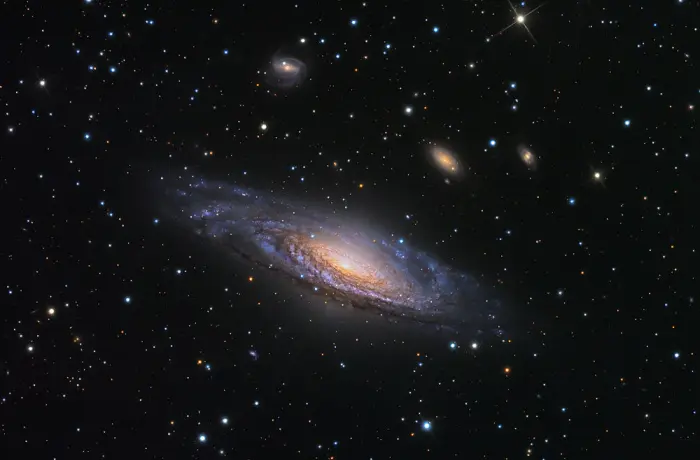
NGC 7331 Acquired with the Schulman Telescope at the Mount Lemmon SkyCenter. Image credit: Adam Block/Mount Lemmon SkyCenter/University of Arizona (CC BY 3.0)
NGC 7331 has a star forming ring about 20,000 light-years from the galactic nucleus. The ring of dust and gas stands out in yellowish hues in the infrared image taken by the Spitzer Space Telescope. It is composed in large part of organic compounds known as polycyclic aromatic hydrocarbons (PAHs). Based on the data obtained with Spitzer, the ring has enough gas to produce four billion Sun-like stars.
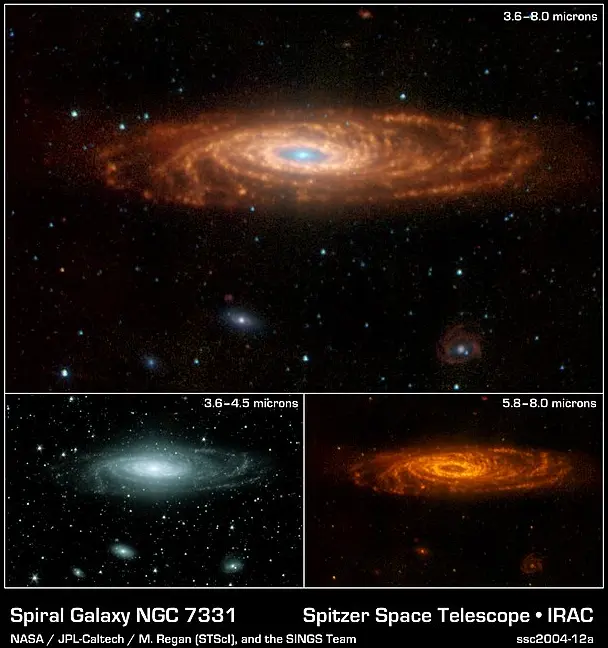
NASA’s Spitzer Space Telescope has captured these infrared images of a nearby spiral galaxy that resembles our own Milky Way. The targeted galaxy, known as NGC 7331 and sometimes referred to as our galaxy’s twin, is found in the constellation Pegasus at a distance of 50 million light-years. This inclined galaxy was discovered in 1784 by William Herschel, who also discovered infrared light. The evolution of this galaxy is a story that depends significantly on the amount and distribution of gas and dust, the locations and rates of star formation, and on how the energy from star formation is recycled by the local environment. The new Spitzer images are allowing astronomers to “read” this story by dissecting the galaxy into its separate components. The main image, measuring 12.6 by 8.2 arcminutes, was obtained by Spitzer’s infrared array camera. It is a four-color composite of invisible light, showing emissions from wavelengths of 3.6 microns (blue), 4.5 microns (green), 5.8 microns (yellow) and 8.0 microns (red). These wavelengths are roughly 10 times longer than those seen by the human eye. The infrared light seen in this image originates from two very different sources. At shorter wavelengths (3.6 to 4.5 microns), the light comes mainly from stars, particularly ones that are older and cooler than our Sun. This starlight fades at longer wavelengths (5.8 to 8.0 microns), where instead we see the glow from clouds of interstellar dust. This dust consists mainly of a variety of carbon-based organic molecules known collectively as polycyclic aromatic hydrocarbons. Wherever these compounds are found, there will also be dust granules and gas, which provide a reservoir of raw materials for future star formation. Three other galaxies are seen below NGC 7331, all about 10 times farther away. From left to right are NGC 7336, NGC 7335 and NGC 7337. The blue dots scattered throughout the images are foreground stars in the Milky Way; the red ones are galaxies that are even more distant. Image credit: NASA/JPL-Caltech/M. Regan (STScI), and the SINGS Team
NGC 7331 Group
NGC 7331 is the brightest member of the NGC 7331 Group, also known as the Deer Lick Group. The visual grouping is not a real galaxy group because NGC 7331 lies much closer to us than the other galaxies and is not physically associated with them. The other galaxies lie at distances of 290-370 million light-years and appear much smaller than NGC 7331. The NGC 7331 Group is catalogued as LGG 459 in the Lyons Groups of Galaxies (LGG) catalogue.
The other members of the NGC 7331 Group are NGC 7335, NGC 7336, NGC 7337, and NGC 7340. These galaxies lie approximately 332, 365, 348, and 294 million light-years away and shine at magnitudes 13.4, 15, 15.2 and 14.9 respectively. NGC 7335 and NGC 7336 are lenticular or unbarred spiral galaxies, NGC 7337 is a barred spiral, and NGC 7340 is an elliptical galaxy. The galaxies do not appear to be associated with each other as they are separated by more than 2 million light-years.
The galaxies were nicknamed the Deer Lick Group by amateur astronomer Tom Lorenzin, who observed NGC 7331 and its smaller companions from the Deerlick Gap Overlook in the mountains of North Carolina in the 1980s. The smaller background galaxies are affectionately known as the “fleas.”
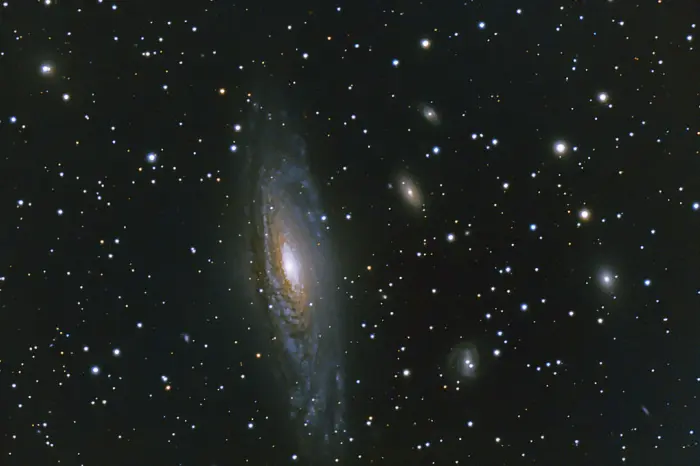
NGC 7331 and the Deer Lick Group, image credit: Wikimedia Commons/Juan Lacruz (CC BY-SA 4.0)
NGC 7331 is believed to be part of a physically associated group of galaxies that also includes NGC 7292, NGC 7363, and NGC 7320. These galaxies do not appear as close to NGC 7331 in the sky as the more distant fleas. NGC 7320 and NGC 7292 were discovered by French astronomer Édouard Stephan in the 1870s, and NGC 7363 was first reported by German astronomer Heinrich Louis d’Arrest in 1865.
The spiral galaxy NGC 7320 is part of Stephan’s Quintet, a visual grouping of five galaxies famously imaged by the James Webb Space Telescope (JWST) in 2022. It is the foreground member of the Quintet, located 39 million light-years away, and the only galaxy in the Quintet that is not a member of the compact galaxy group HCG 92.
Facts
NGC 7331 was discovered by the German-born British astronomer William Herschel on September 5, 1784. It is the brightest galaxy in the constellation Pegasus and one of the brightest cosmic objects not included in the Messier catalogue. The galaxy was included on the original Herschel 400 observing list. William Herschel is also credited for the discovery of NGC 7335, the brightest of the fleas. He first spotted the galaxy on September 13, 1784.
The rest of the Deer Lick Group was discovered in the 19th century. The galaxies NGC 7336, NGC 7337 and NGC 7340 were found by Irish physicist George Stoney on September 10, 1849. At the time, Stoney was an astronomy assistant to William Parsons, 3rd Earl of Rosse at Birr Castle in Ireland. Lord Rosse was present during the discovery and is sometimes credited as the discoverer.
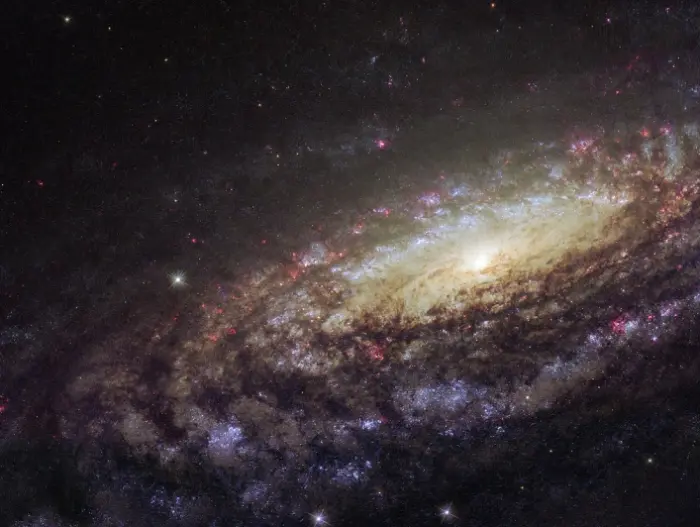
This NASA/ESA Hubble Space Telescope image shows a spiral galaxy known as NGC 7331. First spotted by the prolific galaxy hunter William Herschel in 1784, NGC 7331 is located about 45 million light-years away in the constellation of Pegasus (The Winged Horse). Facing us partially edge-on, the galaxy showcases it’s beautiful arms which swirl like a whirlpool around its bright central region. Astronomers took this image using Hubble’s Wide Field Camera 3 (WFC3), as they were observing an extraordinary exploding star — a supernova — which can still be faintly seen as a tiny red dot near the galaxy’s central yellow core. Named SN2014C, it rapidly evolved from a supernova containing very little Hydrogen to one that is Hydrogen-rich — in just one year. This rarely observed metamorphosis was luminous at high energies and provides unique insight into the poorly understood final phases of massive stars. Image credit: ESA/Hubble & NASA/D. Milisavljevic (Purdue University) (CC BY 2.0)
NGC 7331 has hosted several observed supernova events within the past century. In 1959, SN 1959D was the first supernova discovered in the galaxy. It was detected by Milton L. Humason and H. S. Gates on June 28, 1959, during a supernova search at the Palomar Observatory in California. SN 1959D was classified as a Type IIL supernova, triggered by the core collapse of a massive star. More recently, the supernovae SN 2013bu and SN 2014C were discovered in the galaxy. They were classified as Type IIP and Type Ib supernovae.
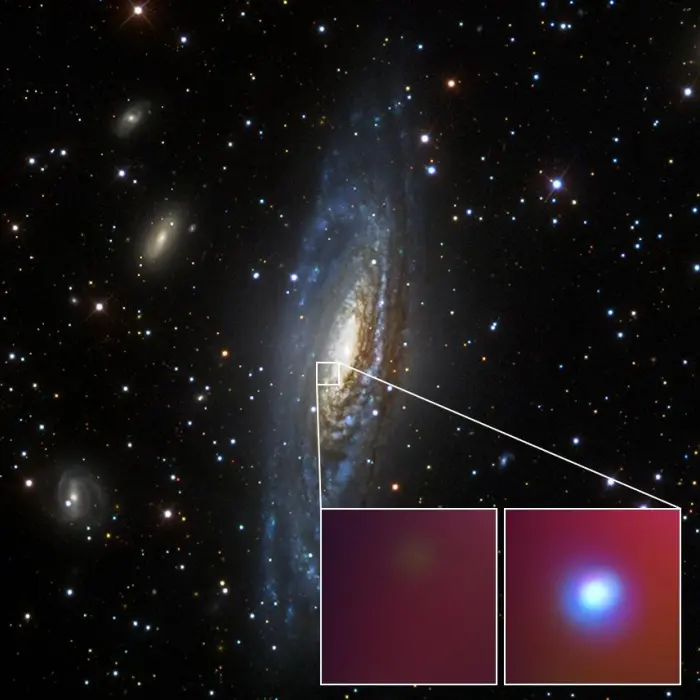
This visible-light image from the Sloan Digital Sky Survey shows spiral galaxy NGC 7331, center, where astronomers observed the unusual supernova SN 2014C. The inset images are from NASA’s Chandra X-ray Observatory, showing a small region of the galaxy before the supernova event (left) and after it (right). Red, green and blue colors are used for low, medium and high-energy X-rays, respectively. X-ray images: NASA/CXC/CIERA/R.Margutti et al; Optical image: SDSS
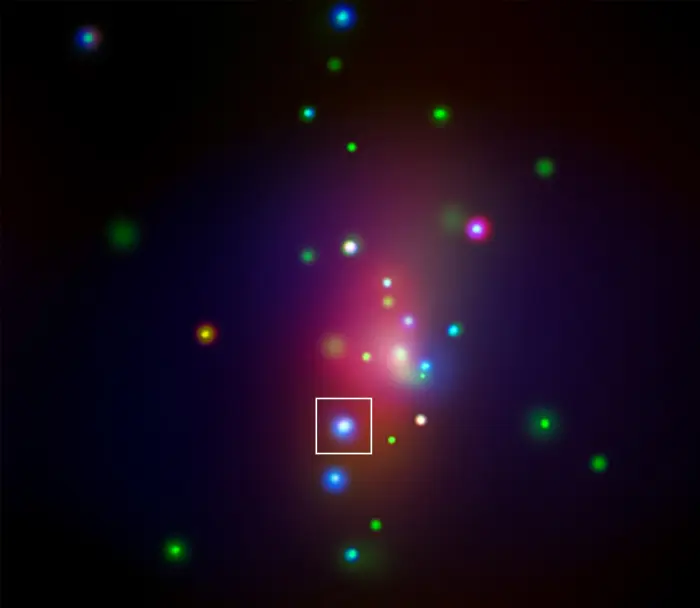
This image from NASA’s Chandra X-ray Observatory shows spiral galaxy NGC 7331, center, in a three-color X-ray image. Red, green and blue colors are used for low, medium and high-energy X-rays, respectively. An unusual supernova called SN 2014C has been spotted in this galaxy, indicated by the box in Figure 1. Image credit: NASA/CXC/CIERA/R.Margutti et al
The galaxy was long called the Milky Way’s twin because it appeared similar in structure and size. The supermassive black hole in the centre of NGC 7331 is about the same size as the Milky Way’s galactic core. The two galaxies appeared to have a comparable star formation rate and contain a similar number of stars. However, they may not be as similar as once believed. NGC 7331 is considerably larger and may be more similar to the Andromeda Galaxy (Messier 31). The Milky Way is now believed to be a barred spiral galaxy, while NGC 7331 is unbarred.
The black hole in the centre of NGC 7331 is a LINER-type active galactic nucleus (AGN). LINER galaxies are quite common. About a third of galaxies in the Milky Way’s neighbourhood may be classified as LINERs.
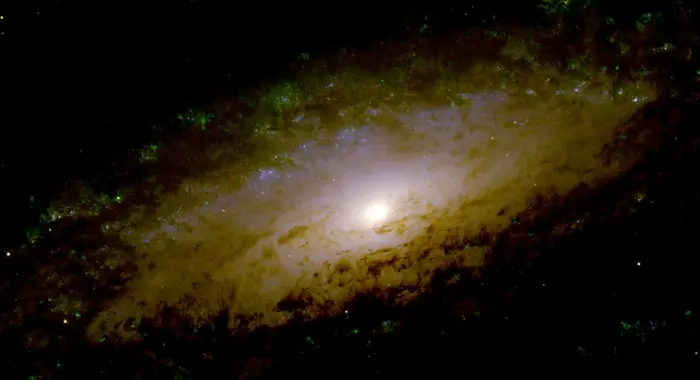
The core of NGC 7331 captured by the Hubble Space Telescope (HST), image credit: NASA/ESA – The Hubble Legacy Archive (HLA): Space Telescope Science Institute (STScI), the Space Telescope European Coordinating Facility (ST-ECF), and the Canadian Astronomy Data Centre (CADC) – zoranknez (FITS Liberator software)
Location
NGC 7331 and the Deer Lick Group are located in the constellation of Pegasus, near the border with Lacerta. NGC 7331 is easy to find because it appears near the Great Square of Pegasus, a bright, prominent asterism that dominates the autumn sky in the northern hemisphere. The galaxy lies about 4.4 degrees north of Matar (Eta Pegasi). Matar is the brightest star just northwest of Scheat (Beta Pegasi), the red giant at the upper right corner of the Great Square. Shining at magnitude 2.95, Matar is the fifth brightest star in Pegasus, after the supergiant Enif and the three Pegasus stars that form the Great Square with Alpheratz in Andromeda. NGC 7331 lies roughly halfway along the imaginary line connecting Algenib in Pegasus and Deneb in Cygnus.
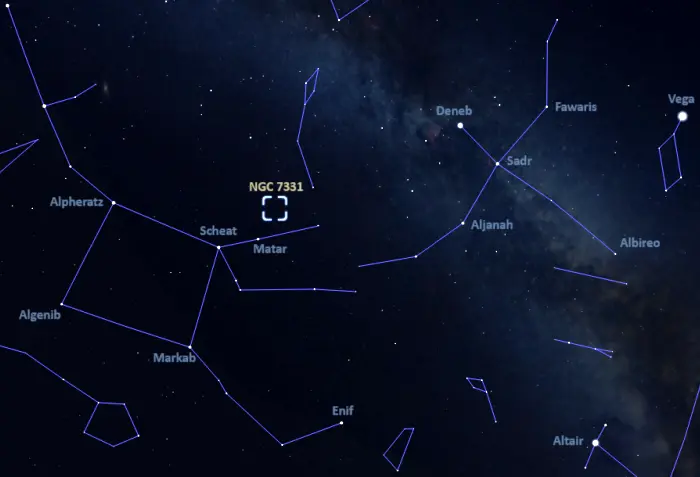
The location of NGC 7331, image: Stellarium
The galaxy can be seen in small telescopes in exceptionally good conditions. It appears as a dim fuzzy spot. While it may also be spotted in 50 mm binoculars, it is best observed in larger instruments. In a 4-inch telescope, the galaxy appears as a faint streak, while 6-inch and 8-inch telescopes may reveal hints of the galaxy’s core. 11-inch telescopes at large magnifications will reveal the bright core surrounded by an elongated faint halo, as well as three of the smaller galaxies near NGC 7331. The darker and clearer the sky is, the more companions are visible. 14-inch telescopes will show a well-defined galactic centre and hints of the dark dust lanes at high magnification.
Stephan’s Quintet appears in the same area, about 0.5 degrees southwest of NGC 7331.
The best time of the year to observe NGC 7331 and other deep sky objects in Pegasus is during the late summer and early autumn, in the months of August, September and October, when the constellation is prominent in the evening sky.
NGC 7331 – Caldwell 30
| Constellation | Pegasus |
|---|---|
| Right ascension | 22h 37m 04.0506038088s |
| Declination | +34° 24′ 56.800076508″ |
| Type | SA(s)b or SAb |
| Apparent magnitude | 10.4 |
| Apparent size | 10′.5 x 3′.7 |
| Distance | 39.8 ± 3.3 million light-years (12.2 ± 1.0 megaparsecs) |
| Redshift | 816 ± 1 km/s |
| Size | 120,000 light-years |
| Names and designations | NGC 7331, Caldwell 30, PGC 69327, UGC 12113, 2E 4630, IRAS F22347+3409, 2MASX J22370410+3424573, MCG+06-49-045, RX J2237.0+3425, SDSS J223704.05+342456.8, Z 514-68, Z 2234.8+3410, UZC J223704.5+342501, Gaia DR3 1903152720991758464 |